In these past four years exploring urbanism — a whirlwind — I have gradually concluded that aesthetics have consequences: beauty is not merely nice to have in the built environment, it is essential. And its widespread absence in the buildings of recent decades is tough to deny. Zoo animals are supposed to have enriched, appealing enclosures. Surely human beings should too. We are told that beauty is subjective, but I wonder if ugliness was modern architecture’s objective.
As a writer I aim to be precise, thoughtful, and well-informed. This essay is a deviation. So I ask you to focus on the general thrust of my argument, that modern architecture’s creators openly declared war on the premise that buildings should be beautiful and inviting. Modern architects consciously created confrontational, austere forms and spaces that they expected most people to find ugly and alienating.
Often credited to the German Bauhaus school of design, this minimalistic, allegedly functional, placeless “International Style” eschewed all beautifying design features, including purely decorative elements known as ornament. A place has particular history, culture, climate, weather, and natural materials. Grand homes in the South Carolina Lowcountry, where I grew up, have multi-story wraparound porches called verandas (for whatever reason I always thought they were called porticos). Modern architecture proposed a new aesthetic vocabulary with a logic outside of time and place — a view from nowhere. That sounds reductive until one examines its history.
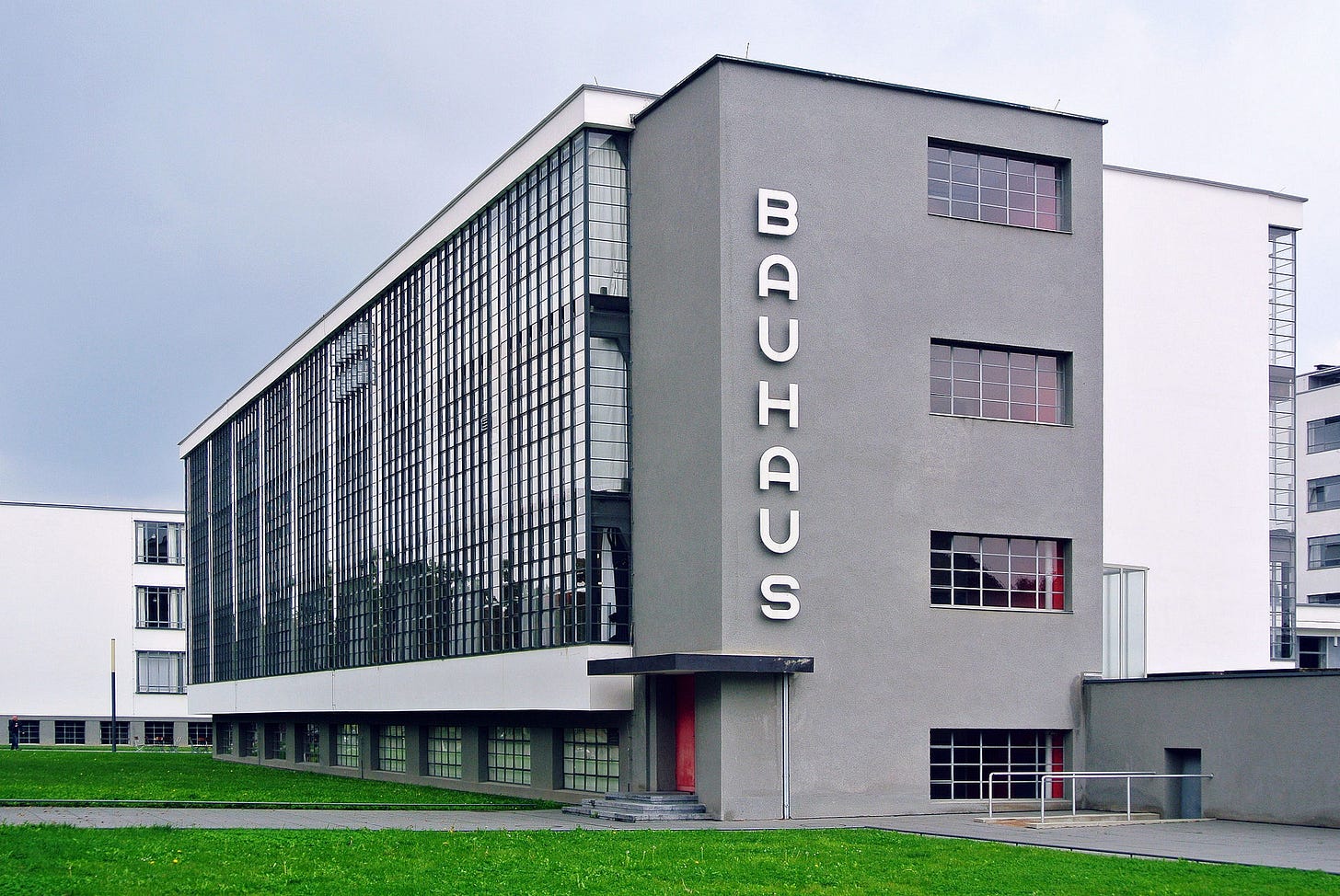
I was edified and inspired by various essays (mostly on Substack). Samuel Hughes, in his widely read meditation on the supposed beauty of concrete in
, blamed modernism, not economic cost concerns. gives an excellent economic account of how skyscrapers became glass boxes, grounded in the financial and power dynamics of real estate development, though he still expresses puzzlement at modern austerity’s persistence. My new Emergent Ventures friend has a beautiful essay arguing that America was supposed to be Art Deco or Art Nouveau — you should read it! (She also argues that the inherent beauty of pencil drawing helped sterile modernism conquer academia.) Megan’s case for beauty largely rests on Tom Wolfe’s book, “From Bauhaus to Our House,” which Scott Alexander of draws similar conclusions from in his shimmering review. And friend of the blog has fumed about modernism and proposed a humble path back to building beautifully of relearning by doing.Alexander opens his review with a Congress for the New Urbanism article about how people psychologically perceive architecture, which quotes researcher Ann Sussman:
A poll that found large majorities prefer traditional architecture over modernism “shows … the biology of human perception at work; modern architecture cannot provide the subliminal fixations, or focal points, the brain needs to find unconsciously to smoothly regulate and feel engaged and at home in a place.”
“Biometric research shows that modern buildings are harder for people to look at, focus on, move towards … What’s striking about biometric studies, like eye-tracking, is you get to see how the architectural experience begins subliminally, or unconsciously in fractions of a second. … They reveal how the human brain is hardwired to make people look away from blank facades, or ones with repetitive parallel lines, and favor ones with the bilateral symmetry and organized curves and complexity traditional facades provide worldwide throughout time.”
Modern architecture threw away significant accumulated knowledge and insight into the human condition. Traditional architectural vernaculars emerged over thousands of years. The rich heritage of Iranian architecture is an excellent example, illustrating that these questions go far beyond Western intellectual and political quarrels.
There are various explanations for why ornamentation became rare in buildings and public spaces across the past few decades. The story appears to be some combination of cultural and economic factors outlined by Wolfe. In broad strokes:
Modern architecture emerged from a Marxist artistic collective called Bauhaus that was obsessed with discarding all aesthetic trappings of the bourgeoise, even functional elements like slopped roofs in snowy climes, with no regard for the views of working-class artisans, who were haughtily dismissed as unsophisticated.
These modernists fled the Nazis (with a notable exception, discussed below) into the warm embrace of American elites, who put them in charge of institutions such as the Yale School of Architecture, where they had enormous influence.
Modernism’s cultural clout gave businesses and governments a rationale to build cheap and plain. This cratered demand for the artisans and builders who specialized in creating beauty, largely killing off their knowledge and skills. Today, such services are exorbitantly expensive or virtually impossible to find.
My contribution to the Substack discourse: Aesthetics is a statement of values, and the value that modern architecture expressed was nihilism. As Megan quotes Wolfe:
The country of the young Bauhäusler, Germany, had been crushed in the war and humiliated at Versailles; the economy had collapsed in a delirium of inflation; the Kaiser had departed; the Social Democrats had taken power in the name of socialism; mobs of young men ricocheted through the cities drinking beer and awaiting a Soviet-style revolution from the east, or some terrific brawls at the very least. Rubble, smoking ruins — starting from zero! If you were young, it was wonderful stuff. Starting from zero referred to nothing less than re-creating the world.
The rub is, Bauhaus went beyond functional minimalism. Its architects seemed to take pleasure in creating housing that demoralized workers. As Alexander quotes Wolfe:
In matters of taste, the architects acted as the workers’ cultural benefactors. There was no use consulting them directly, since, as Gropius had pointed out, they were as yet “intellectually undeveloped”.
In fact, here was the great appeal of socialism to architects in the 1920s. Socialism was the political answer, the great yea-saying [editor note: huh?], to the seemingly outrageous and impossible claims of the compound architect, who insisted that the client keep his mouth shut. Under socialism, the client was the worker. Alas, the poor devil was only just now rising up out of the ooze. In the meantime, the architect, the artist, and the intellectual would arrange his life for him. To use Stalin’s phrase, they would be the engineers of his soul. In his apartment blocks in Berlin for employees of the Siemens factory, the soul engineer Gropius decided that the workers should be spared high ceilings and wide hallways, too, along with all of the various outmoded objects and decorations. High ceilings and wide hallways and “spaciousness” in all forms were merely more bourgeois grandiosity, expressed in voids rather than solids. Seven-foot ceilings and thirty-six-inch-wide hallways were about right for . . . re-creating the world.
Modern architecture would be quite defensible if it were strictly functional, but Bauhaus really did insist on flat roofs that snow would pile onto. Modernism was placeless and faceless in defiance of practicality. Apologists for modernism reflexively insist that aesthetics, beauty, and ugliness are subjective. But of course Bauhaus was ugly; that was the whole point of stripping away all ornamentation and color. Why else prioritize plainness over function? The worker housing sent an implicit but overwhelming message to the people who lived in it: This is not for you.
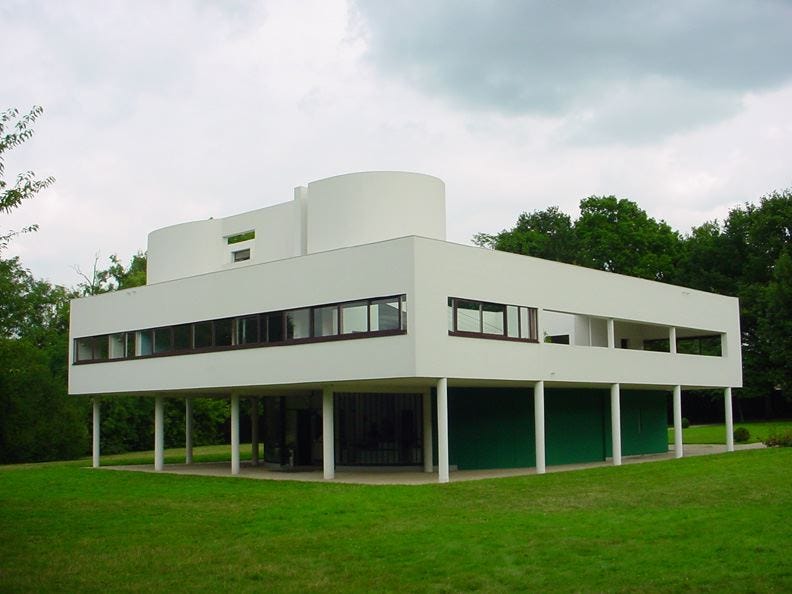
That brings us, at Megan’s wise suggestion, to Le Corbusier, who gave himself that nickname and insisted that people use it, so you just know the guy was bad news.
“The Crow-like One,” adapting his nom de plumage from Belgian ancestors, was a leading light of modern architecture and urban planning. His massive “superblocks” took cities beyond petty pedestrian concerns of human scale. He championed austere design with an arrogance I can only call French. He is of particular interest to us because of his yearning for totalitarian patrons. His four-year relationship with the Soviet Union ended in humiliation in 1932 when his design for a palatial political convention center was rejected. He later offered his services to the French Vichy government under Nazi occupation. He was also a conspicuous admirer of Mussolini, which is tricky for me because my grandfather was forced to join the fascist party.
As for what his fellow travelers called “the Jewish question,” Le Corbisier only expressed antisemitic views in private writings, according to his defender in a BBC article about his fascist sympathies, which is, obviously, a huge relief. “All the quotations on racism or fascism came from extracts of his private correspondence - he never published anything, nor made any public declaration against Jews.” His apologists note he was accused of being a communist too, not just a fascist, so there!
Rather than dwell on one man, I direct your attention back to the architecture. When we look at modernist buildings, and step inside, what do we see? And what do we feel?
I find the theory that modern aesthetics are intended to demoralize the population increasingly plausible. The denial that a concrete box is ugly or insistence that the observer is simply unsophisticated is not merely an appeal to relativism or erudition. It can be a power play. If you can force someone to accept a spurious denial of their concerns, you are demonstrating a power over language and maybe over what is considered to be true. That workers or artisans were incorrect or vulgar was immaterial, because they had no choice but to accept featurelessness. This aesthetic nihilism came to dominate the buildings and public spaces of capitalist nations, an elaborate practical joke that Marx would presumably find funny.
For balance, I must note my affection for some modern buildings. The National Gallery of Art’s East Building, particularly its atrium, is starkly beautiful and fits the modern art it houses. I can appreciate and enjoy this without explanation:
Even the former National Association of Broadcasters building in DC has an obvious geometric beauty and order. The fountain (turned off) is a great place to view it.

I always appreciated the FBI’s widely-hated, ominous, intimidating DC headquarters:
Yet there can be no excuse for the the American Institute of Architects’ grotesque headquarters in DC. I walked past it on my way to the lovely Constitution Hall.
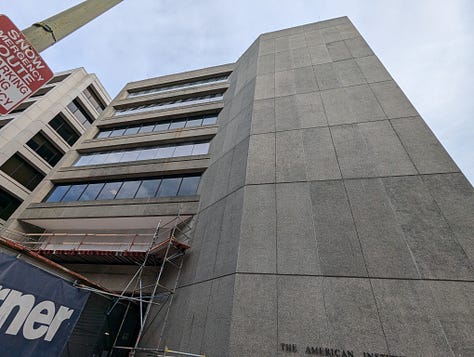
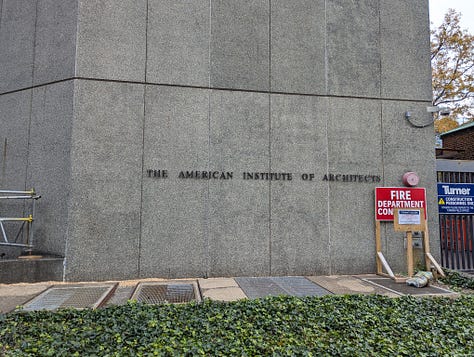
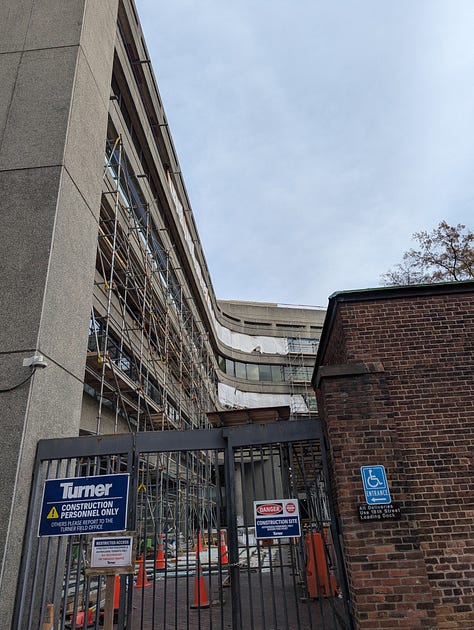
We should question this. We should examine what we lost when architects in the thrall of a modernist cultural revolution discarded essentially all tradition and style. You do not have to like modern architecture. Maybe you were never supposed to.
You need not claim to know what good looks like. I approach that matter with trepidation and humility. I do have some crude notions, which I may share in the future, in case you would enjoy an even vaguer essay resembling a Pinterest board.
Here I confess to finding Roger Scruton’s famous documentary on beauty rather compelling when I breezed through it. His appeals to common sense are undeniable.
One piece of traditional architecture that did arrest my attention is Milwaukee City Hall, pictured up top. It was, upon completion in 1895, the tallest habitable structure in the United States, at 353 feet. Its beauty is unmistakable.
My developer pal Seth pointed out that if large buildings are beautiful, there is no need to “break up the massing.” And if buildings in general are more visually appealing, regular people may associate development and growth less with ugliness and misanthropy. We need beautiful buildings the way we need sunshine and trees and art. Trying to objectively define beauty is beside the point, and often a straw man, a distraction. Architecture should not be defined by an absence of meaning.
Thanks to my 943 subscribers, especially my 14 paid subscribers. If you enjoy this blog or want to work together please contact lucagattonicelli@substack.com. Check out YIMBYs of Northern Virginia, the grassroots pro-housing organization I founded.
Highland Park Captured My Heart
On a recent road trip, we stopped in Pittsburgh to catch up with my best friend from childhood over lunch at a family-friendly bistro. Highland Park is a streetcar suburb about 15 minutes from downtown by car. I was blown away by its rich fabric of closely spaced homes with porc…



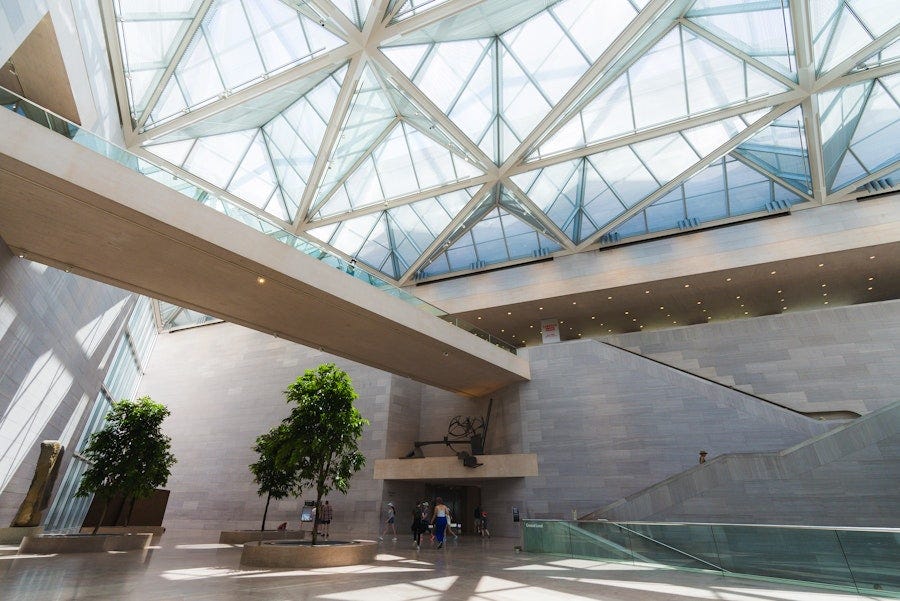

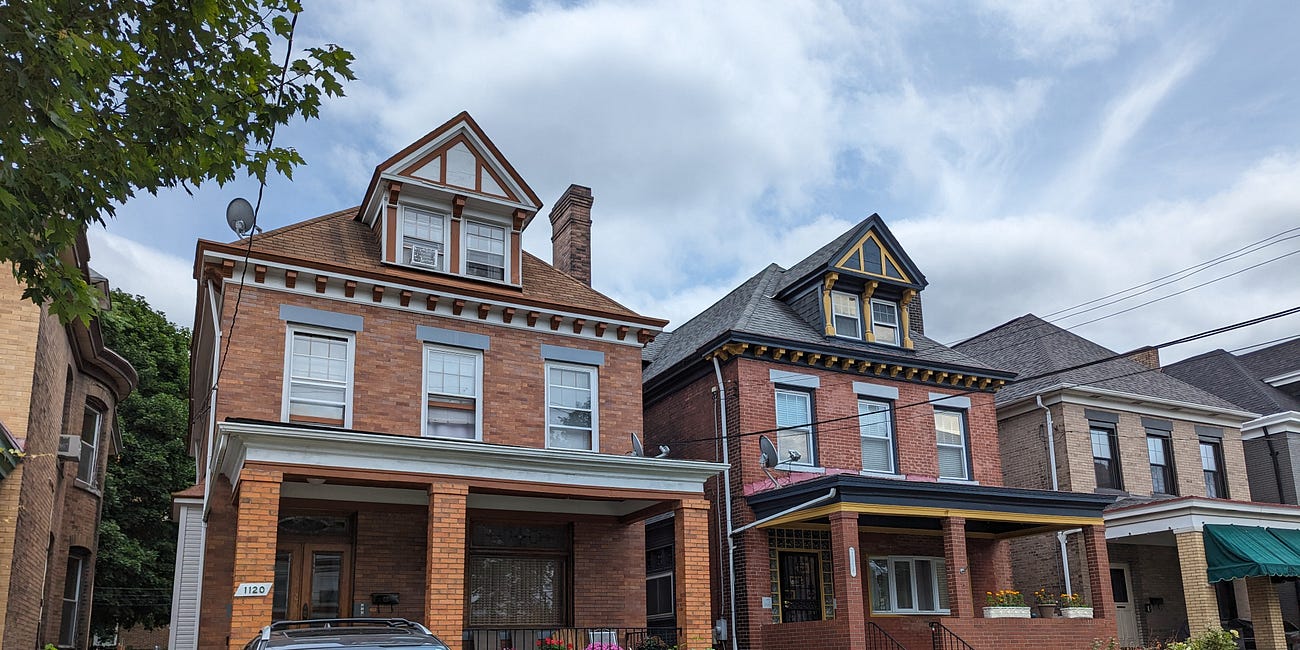
Two interrelated thoughts: many of the modern and post modern designs that I see in New England were built during the 1950s and 60s as part of the urban renewal programs that wiped out "blighted" neighborhoods. To my eye, blocks with mixed architectural styles are most intriguing as the designs play off each other. That interplay with historic designs is absent from most of the of the urban renewal planning and many of the buildings fail to celebrate the design possibilities created by the modern style. Second, so much of that design type ignores the proportions of neighborhoods that make people feel welcome and safe. Jane Jacobs' book The Death and Life of Great American Cities is all about this failure.
The result is sub-par designs created in a scale that makes us feel uncomfortable. No wonder people don't like most of it.
Why does it have to be either / or? There is so much great modernist architecture! There is so much terrible modernist architecture! Both are true. I also disagree that the values expressed by a style of architecture are uniform. Maybe a few guys in one decade all had the same idea, but many descendants of the style have an array of values they are trying to express through their reinventions. I also think that while the examples of bad architecture are fair, you need to talk about skyscrapers which were really where modern architecture actually was most expressed. I want to see you argue with Lever House! And most of midtown Manhattan and downtown Chicago etc. I would hate to live in a world where we have a consensus view of beauty, personally. Anyway, I want to re-read your piece but these are some quick initial responses.